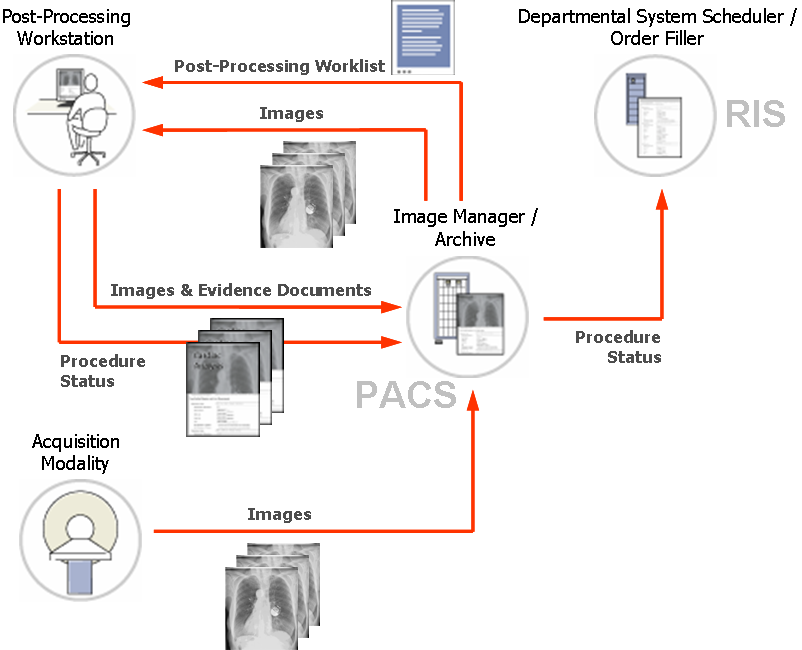Post-Processing Workflow
[PWF] Post-Processing Workflow provides worklists, status and result tracking for post-acquisition tasks, such as Computer-Aided Detection or Image Processing.
Summary
The Post-Processing Workflow Profile provides the means to organize and schedule post-processing tasks and to monitor their progress and completion.
The Post-Processing Workflow Integration Profile is a natural / logical extension of the Scheduled (Acquisition) Workflow Profile and provides the capabilities to sustain and optimize several tasks typically performed after image acquisition in preparation for the following image interpretation (reporting). It specifies transactions to support a seamless flow of information for typical post-processing tasks such as: quality control, image reconstruction, Computer Aided Detection, 3D views generation.

Benefits
The Post-Processing Workflow Profile improves the efficiency of post-processing tasks providing the users with ready-made worklists (to-do lists) where they can simply pick the next task to perform and have immediate access to relevant patient and procedure information and to the images to be processed. Time and efforts are greatly reduced, as users don’t have to manually search or inquire for patient and procedure data, nor do they have to handle paper or film.
Consistency and integrity of patient and clinical information can easily be maintained as the integrated systems can preserve the proper correlation of patient demographics, order information and procedure data with the generated images and post-processing results.
The status of the post-processing tasks (scheduled, in progress, completed) can be closely monitored to facilitate performance statistics and to derive provisions for improvements of the imaging department’s efficiency.
Notification of completion of procedures can be used by scheduling systems to initiate preparations for follow-up actions such as image interpretation (reporting) or setting-up additional diagnostic or patient treatment procedures.
Also details of the effectively performed tasks and utilized resources and materials are essential input for an accurate charging of radiological services.
Enabling an unobstructed information flow from system to system eliminates the need of redundant and error-prone manual re-capture of data, ensures consistency and integrity of patient data and allows the medical staff to focus on the tasks at hand rather than having to deal with the deficiencies of non-integrated devices and IT systems.
Details
The Post-Processing Workflow Integration Profile addresses the following functions and systems interactions:
- Planning – a scheduling system (RIS, PACS) assembles and prepares the data needed to perform certain post-processing tasks.
- Provide Worklists – a post-processing workstation (3D Workstation) queries the scheduling system for worklists (lists of 3D post-processing tasks to be preformed) and presents the information to the user.
- Post-Processing – the workstation user selects (claims) a certain task to work on, retrieves the images pertinent to the selected task, performs the appropriate post-processing procedures and generates additional results (reconstructed images, measurements, findings) to be stored. The correlation of patient, procedure, images and results information can be properly maintained.
- Status-Tracking – the workstation keeps the scheduling system informed about the status of the procedure: claimed, in progress, completed.
- Once a post-processing procedure has been completed it can be removed from the schedule, another pending work item can be taken on, and so forth.
Systems Affected
- RIS – may act as a scheduler of post-processing tasks or (if the PACS assumes the scheduling role) at least keeps track of the procedure states to remain in sync with the PACS.
- PACS – may act as a scheduler of post-processing tasks or (if the RIS assumes the scheduling role) at least keeps track of the procedure states to remain in sync with the RIS. The PACS also stores and manages images (both acquired and post-processed) and related results (measurements, CAD results or other clinical evidences).
- Post-Processing Workstation – a specialized workstation capable of querying a PACS or RIS for post-processing worklists, performing specialized post-processing procedures, generating results (images, measurements, evidence documents) and returning post-processing status information to the scheduling system.
Actors & Transactions:
Specification
Profile Status: Final Text
Documents: IHE Radiology Technical Framework:
Underlying Standards: Elements of the following standards have been used to specify the implementation details of the Post-Processing Workflow Integration Profile:
See Also
Related Profiles
- Scheduled Workflow (SWF)
- Evidence Documents (ED)
- Key Image Notes (KIN)
- Consistent Presentation of Images (CPI)
- NM Image
- Reporting Workflow (RWF)
- Charge Posting (CHG)
Consumer Information
The Profile FAQ Template answers typical questions about what the Profile does. <Replace the link with a link to the actual FAQ page for the Profile>
The Profile Purchasing Template describes considerations when purchasing equipment to deploy this Profile. <Replace the link with a link to the actual Purchasing page for the Profile>
Implementer Information
The Profile Implementation Template provides additional information about implementing this Profile in software. <Replace the link with a link to the actual Implementation page for the Profile>
Reference Articles
<List References (good and bad) (with link if possible) to Journal Articles that mention IHE's work (and hopefully include some analysis) >
This page is based on the Profile Template